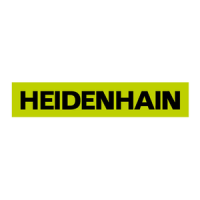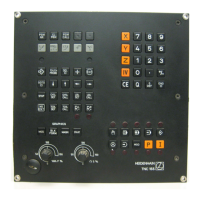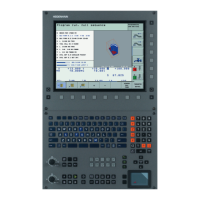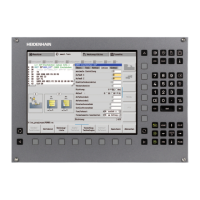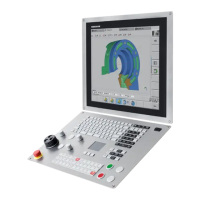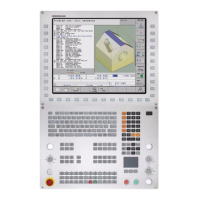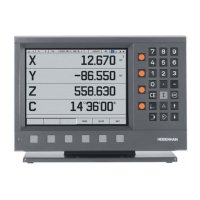Do you have a question about the HEIDENHAIN TNC 430 and is the answer not in the manual?
Details writing part programs, using FK feature, cycles, and Q parameters with graphics.
Describes the procedure for switching the TNC on and off safely.
Explains setting the datum by manually positioning the tool on known workpiece points.
Guides through entering a part program, selecting units, and defining the BLK-FORM.
Explains how to execute a pallet file using PGM MGT and the NC Start button.
Explains setting up pallet files by defining planes: PAL, FIX, PGM, and their details.
Covers entering feed rate F and spindle speed S in TOOL CALL blocks.
Provides an overview of path functions like line, chamfer, circle, and corner rounding.
Covers fundamentals, graphics, and free programming of straight lines and circular arcs.
Explains using M functions for program control, spindle, coolant, and entering STOP blocks.
Details machine-referenced coordinates (M91/M92) and datum handling.
Covers functions like smoothing corners (M90), rounding arcs (M112), and small contour steps (M97).
Explains feed rate for rotary axes (M116), shorter path traverse (M126), and axis reduction (M94).
Explains defining cycles using soft keys or the GOTO function.
Details cycles for pecking, drilling, reaming, boring, tapping, and thread milling.
Covers cycles for pocket milling, stud finishing, slot milling, and circular patterns.
Explains cycles for circular and linear hole patterns.
Enables forming complex contours by combining subcontours.
Covers datum shift, mirror image, rotation, scaling, and working plane.
Introduces Q parameters for programming variables, contours, and logical conditions.
Explains using Q parameters for programming families of parts with characteristic dimensions.
Details basic mathematical functions like ASSIGN, ADDITION, SUBTRACTION, MULTIPLICATION, DIVISION.
Explains making logical decisions by comparing Q parameters or numerical values.
Explains entering mathematical formulas with multiple operations directly via soft keys.
Lists Q parameters assigned by the TNC, including PLC values, tool/spindle data, and status.
Covers simulating programs to prevent errors and available functions like blockwise test.
Explains continuous or single-block program execution and related functions.
Describes programmed interruptions, machine STOP button, and switching to single block mode.
Covers resuming programs after interruption or errors using START or system restart.
Details starting a part program at any block using RESTORE POS AT N.
Provides additional displays and input possibilities depending on the selected operating mode.
Covers setting up RS-232, RS-422 interfaces, operating mode, and BAUD rate.
Describes connecting the TNC to a network via Ethernet card and its configuration.
Details general network settings like ADDRESS, MASK, ROUTER, PROT, HW, HOST.
Enables graphical check of workpiece blank position and work space monitoring.
Allows setting axis traverse limits and viewing datum display.
Details writing part programs, using FK feature, cycles, and Q parameters with graphics.
Describes the procedure for switching the TNC on and off safely.
Explains setting the datum by manually positioning the tool on known workpiece points.
Guides through entering a part program, selecting units, and defining the BLK-FORM.
Explains how to execute a pallet file using PGM MGT and the NC Start button.
Explains setting up pallet files by defining planes: PAL, FIX, PGM, and their details.
Covers entering feed rate F and spindle speed S in TOOL CALL blocks.
Provides an overview of path functions like line, chamfer, circle, and corner rounding.
Covers fundamentals, graphics, and free programming of straight lines and circular arcs.
Explains using M functions for program control, spindle, coolant, and entering STOP blocks.
Details machine-referenced coordinates (M91/M92) and datum handling.
Covers functions like smoothing corners (M90), rounding arcs (M112), and small contour steps (M97).
Explains feed rate for rotary axes (M116), shorter path traverse (M126), and axis reduction (M94).
Explains defining cycles using soft keys or the GOTO function.
Details cycles for pecking, drilling, reaming, boring, tapping, and thread milling.
Covers cycles for pocket milling, stud finishing, slot milling, and circular patterns.
Explains cycles for circular and linear hole patterns.
Enables forming complex contours by combining subcontours.
Covers datum shift, mirror image, rotation, scaling, and working plane.
Introduces Q parameters for programming variables, contours, and logical conditions.
Explains using Q parameters for programming families of parts with characteristic dimensions.
Details basic mathematical functions like ASSIGN, ADDITION, SUBTRACTION, MULTIPLICATION, DIVISION.
Explains making logical decisions by comparing Q parameters or numerical values.
Explains entering mathematical formulas with multiple operations directly via soft keys.
Lists Q parameters assigned by the TNC, including PLC values, tool/spindle data, and status.
Covers simulating programs to prevent errors and available functions like blockwise test.
Explains continuous or single-block program execution and related functions.
Describes programmed interruptions, machine STOP button, and switching to single block mode.
Covers resuming programs after interruption or errors using START or system restart.
Details starting a part program at any block using RESTORE POS AT N.
Provides additional displays and input possibilities depending on the selected operating mode.
Covers setting up RS-232, RS-422 interfaces, operating mode, and BAUD rate.
Describes connecting the TNC to a network via Ethernet card and its configuration.
Details general network settings like ADDRESS, MASK, ROUTER, PROT, HW, HOST.
Enables graphical check of workpiece blank position and work space monitoring.
Allows setting axis traverse limits and viewing datum display.
| Control Type | CNC |
|---|---|
| Display | Color LCD |
| Number of Axes | Up to 5 |
| Input Voltage | 24 V DC |
| DNC Operation | Yes |
| Interfaces | RS-232, Ethernet |
| Axis Control | Digital |
| Spindle Control | Digital |
| Operating Modes | Manual, Automatic |
| Supported G-Code | DIN/ISO |
